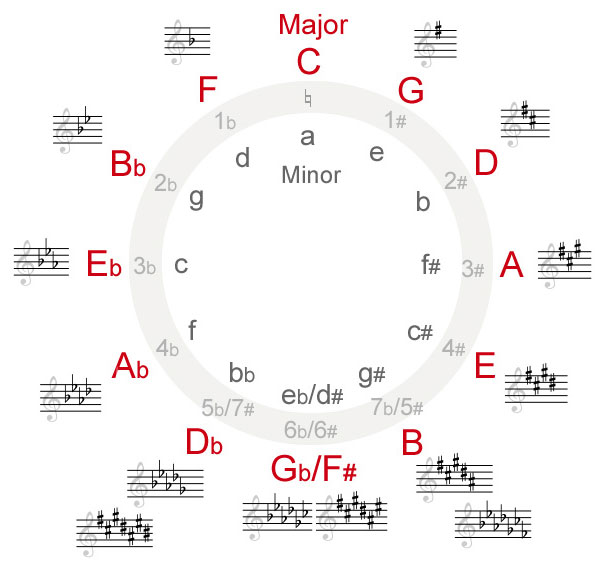Key Signitures
Sharps
| Key | No’ of sharps | Sharp notes |
|---|---|---|
| C major | 0 | |
| G major | 1 | F# |
| D major | 2 | F#, C# |
| A major | 3 | F#, C#, G# |
| E major | 4 | F#, C#, G#, D# |
| B major | 5 | F#, C#, G#, D#, A# |
| F# major | 6 | F#, C#, G#, D#, A#, E# |
| C# major | 7 | F#, C#, G#, D#, A#, E#, B# |
Flats
| Key | No’ of flats | Flat notes |
|---|---|---|
| C major | 0 | |
| F major | 1 | B♭ |
| B♭ major | 2 | B♭, E♭ |
| E♭ major | 3 | B♭, E♭, A♭ |
| A♭ major | 4 | B♭, E♭, A♭, D♭ |
| D♭ major | 5 | B♭, E♭, A♭, D♭, G♭ |
| G♭ major | 6 | B♭, E♭, A♭, D♭, G♭, C♭ |
| C♭ major | 7 | B♭, E♭, A♭, D♭, G♭, C♭, F♭ |
A guide to Key Signatures
A key is the major or minor scale around which a piece of music revolves. Each major and minor key has an associated key signature that sharpens or flattens the notes which are used in its scale. The convention for the notation of key signatures follows the circle of fifths.
Starting from C major (or equivalently A minor) which has no sharps or flats, successively raising the key by a fifth adds a sharp, going clockwise round the circle of fifths. The new sharp is placed on the new key’s leading note (seventh degree) for major keys or supertonic (second degree) for minor keys. Thus G major (E minor) has one sharp which is on the F; then D major (B minor) has two sharps (on F and C) and so on.
Similarly successively lowering the key by a fifth adds a flat, going counter-clockwise round the circle of fifths. The new flat is placed on the subdominant (fourth degree) for major keys or submediant (sixth degree) for minor keys. Thus F major (D minor) has one flat which is on the B; then B♭ major (G minor) has two flats (on B and E) and so on.
In the diagram above major keys are indicated by red capital letters and the minor keys are indicated by grey lowercase letters.
Root Note or Tonic
The root note (or tonic) of a key acts as the center of the key. Similar to the root notes of chords, the root note of a scale is the note on which a scale is built.
A song played in the ‘key of C major’ revolves around the seven notes of the C major scale – C, D, E, F, G, A, and B, a song played in the ‘key of A minor’ revolves around the seven notes of the A minor scale – A, B, C, D, E, F, and G. As stated both have no sharps or flats.
Where as a song played in the ‘Key of F major’ (F, G, A, Bb, C, D, and E) and the ‘Key of D minor’ (D, E, F, G, A, Bb, and C) both need to have one flat note. Similarly the ‘Key of G major’ and the ‘Key of E minor both require one sharp note to balance tonally. And so on…
Cirle of Fifths
Notice in the table for sharps it shows that each scale starting on the fifth scale degree of the previous scale has one new sharp, added in the order given above. Where as in the table for flats each new scale starts a fifth below (or a fourth above) the previous one.
A key signature is not the same as a key; key signatures are merely notational devices. They are convenient principally for diatonic or tonal music.
For a given musical mode the key signature defines the diatonic scale that a piece of music uses. Most scales require that some notes be consistently sharped or flatted. For example, the only sharp in the G major scale is F sharp, so the key signature associated with the G major key is the one-sharp key signature.

